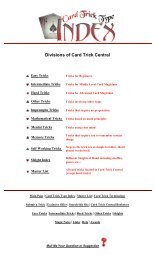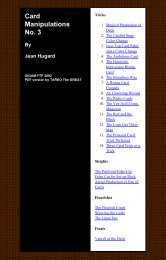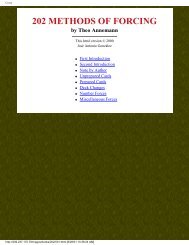The Encyclopedia of Card Tricks-Cover - Umclidet
The Encyclopedia of Card Tricks-Cover - Umclidet
The Encyclopedia of Card Tricks-Cover - Umclidet
You also want an ePaper? Increase the reach of your titles
YUMPU automatically turns print PDFs into web optimized ePapers that Google loves.
<strong>The</strong> <strong>Encyclopedia</strong> <strong>of</strong> <strong>Card</strong> <strong>Tricks</strong><br />
[ Main Contents ] [ Next Chapter ] [ Previous Chapter ]<br />
Chapter XIV<br />
~Magic With a Mene-Tekel Pack <strong>of</strong> <strong>Card</strong>s~<br />
Contents<br />
<strong>Card</strong> and Number<br />
<strong>Card</strong> Into Pocket - A Second Method<br />
<strong>Card</strong>s and Slates<br />
Coincidence Mene-Tekel<br />
Controlling Several <strong>Card</strong>s<br />
From A Hat<br />
One in Four<br />
Pocket Rising <strong>Card</strong>, <strong>The</strong><br />
<strong>The</strong> Mene-Tekel Pack<br />
<strong>The</strong> Mene-Tekel Pack<br />
IT IS not certainly known who devised this variation <strong>of</strong> the<br />
combination <strong>of</strong> long and short cards, but the title, 'Mene-Tekel',<br />
was first applied to it by the late W. D. Leroy, the well-known<br />
magical dealer <strong>of</strong> Boston. Like the Svengali pack it consists <strong>of</strong><br />
twenty-six ordinary cards and twenty-six short cards but instead<br />
<strong>of</strong> the short cards being all <strong>of</strong> the same suit and value, they also<br />
are all different, each short card being <strong>of</strong> the same suit and value<br />
as its neighboring ordinary card so that the pack consists <strong>of</strong><br />
twenty-six pairs <strong>of</strong> cards, one short and one ordinary card <strong>of</strong> the<br />
same suit and value in each pair.<br />
To construct such a pack obtain two packs <strong>of</strong> cards, with the same<br />
back patterns, the cards preferably being thin and pliable and not<br />
too slippery. Thoroughly shuffle one pack and count <strong>of</strong>f twenty-six<br />
cards. <strong>The</strong>n from the second pack take twenty-six cards <strong>of</strong> the<br />
same denomination as in the first and arrange them in the same<br />
order. You will then have two packets <strong>of</strong> cards exactly similar.<br />
From the ends <strong>of</strong> one set shave <strong>of</strong>f about one-sixteenth <strong>of</strong> an inch.<br />
This may be done with a photoprint trimmer, or, better still, a<br />
bookbinder's guillotine if you have access to one. Having thus<br />
shortened one set <strong>of</strong> cards, arrange the whole fifty-two in pairs,<br />
the short card being the top card <strong>of</strong> each pair, and the Mene-Tekel<br />
pack is set-up.<br />
To show the cards apparently all different riffle the ends slowly<br />
before the audience, the faces <strong>of</strong> the ordinary cards only will show<br />
up. Or, you may hold the pack upright, thumb at the top end, and<br />
let the cards fall forward on to the left hand, again showing only<br />
the faces <strong>of</strong> the ordinary cards. <strong>The</strong> pack may be riffle shuffled<br />
without disarranging the cards.<br />
To do this, square up the pack by tapping one end on the table to<br />
settle the short cards, then while the pack is on end, divide it<br />
about in half so that a short card is on the top <strong>of</strong> the lower<br />
portion. Riffle the two halves one into the other in the usual way,<br />
the cards will fall in pairs and the sequence <strong>of</strong> the prepared pack is<br />
not destroyed. <strong>The</strong> pairs will occupy different positions, but each<br />
pair will be intact. In similar fashion the pack can be cut<br />
indefinitely with complete cuts without separating the pairs, since<br />
the cut will always be made at one <strong>of</strong> the ordinary cards.<br />
To illustrate the use <strong>of</strong> the pack for controlling a freely chosen card<br />
slowly riffle it and request a spectator to insert his forefinger, or a<br />
paper knife, anywhere he pleases and take the card next below his<br />
finger or the knife. In every case that card will be a short card and<br />
the next card (ordinary card) will be the duplicate <strong>of</strong> the one<br />
chosen. As the spectator takes the card raise the portion in the<br />
right hand and separate the hands a little, then casually place the<br />
two portions <strong>of</strong> the pack together but put the cards in the left<br />
hand on top <strong>of</strong> those in the right hand. This departure from the<br />
regular way <strong>of</strong> assembling the pack will never be noticed,<br />
however, if it is preferred you may openly cut at the point from<br />
which the card was removed. <strong>The</strong> result is that you now have on<br />
the top <strong>of</strong> the pack the duplicate <strong>of</strong> the card chosen. <strong>The</strong> card may<br />
then be dealt with in any <strong>of</strong> the following ways.<br />
1. <strong>The</strong> spectator, having noted his card, replaces it in any part<br />
<strong>of</strong> the pack which you at once square up very openly.<br />
Request him to blow on the top card, name the card he<br />
drew, and turn the top card, it is his card. If it is desired to<br />
repeat the trick you will have to find the odd one and again<br />
bring it on top <strong>of</strong> its duplicate.<br />
2. <strong>The</strong> duplicate may be revealed by holding the pack a short<br />
distance above the table, secretly push the card a little <strong>of</strong>f<br />
the pack sideways, and the action <strong>of</strong> dropping the pack will<br />
cause the card to turn over and appear face up.<br />
3. <strong>The</strong> card may be forced right out <strong>of</strong> the pack and passed<br />
through the table. To do this, secretly wet the back <strong>of</strong> your<br />
right hand. Show the spectator how you wish him to apply<br />
pressure. Put the back <strong>of</strong> your right hand right on top <strong>of</strong> the<br />
pack and your left hand palm downwards on that. Press<br />
down firmly and the top card will adhere to the back <strong>of</strong> your<br />
right hand, which you pass under the table top. <strong>The</strong><br />
spectator places his hands on the pack in the same way and<br />
presses firmly. Have the card named and produce it from<br />
under the table.<br />
4. As the spectator notes his card, secretly glimpse the top<br />
card. Tell him to concentrate his thoughts on the name <strong>of</strong><br />
his card and you read his mind in the usual fashion, first<br />
getting the color <strong>of</strong> his card, then the suit and finally the<br />
value. By having the card returned to the top the pack will<br />
be in order for another demonstration.<br />
5. After the card has been selected and the shift made<br />
bringing the duplicate to the top, put the pack in your left<br />
outside coat pocket for a moment, thumbing <strong>of</strong>f the top<br />
card and leaving it in the pocket. Bring the pack out again<br />
under pretense <strong>of</strong> having forgotten to have the chosen card<br />
replaced. Have it pushed into the pack and at once place<br />
the pack in your right-hand pocket. Have the card named<br />
and order it to pass across into the left pocket, from which<br />
you produce it.<br />
6. After the return <strong>of</strong> the card to the middle, square up the<br />
cards very openly, then hold the pack upright in your right<br />
hand, face <strong>of</strong> the bottom card towards the spectators. Order<br />
the card to rise and push up the top duplicate card with tips<br />
<strong>of</strong> the first and second fingers. It will appear to rise from<br />
the middle <strong>of</strong> the pack.<br />
Chapter Contents<br />
Controlling Several <strong>Card</strong>s<br />
BRING the duplicate <strong>of</strong> the first card to the top as already<br />
explained, leave the chosen card in the first spectator's hands and<br />
go to a second person. When he draws a card do not pass the<br />
upper portion to the bottom as before, simply lower the top packet<br />
to the side <strong>of</strong> the lower one and with the thumb <strong>of</strong> the left hand<br />
push the top card <strong>of</strong> the lower on top <strong>of</strong> the right-hand packet and<br />
replace this packet on top. Thus the duplicate <strong>of</strong> the second<br />
spectator's card is now on top <strong>of</strong> the pack, and the first person's<br />
duplicate card is the second card. You follow exactly the same<br />
process for as many cards as you wish to have chosen so that<br />
finally you have duplicates <strong>of</strong> all the cards on the top <strong>of</strong> the pack,<br />
but you must remember that these are in the reverse order to that<br />
in which the short cards were drawn.<br />
Chapter Contents<br />
<strong>Card</strong> Into Pocket. A Second<br />
Method<br />
A CARD having been drawn and the duplicate brought to the top,<br />
you very thoughtfully turn your back to enable the spectator to<br />
show the selected card to everyone else. Seize the opportunity to<br />
note what the top card is and slip it into a pocket. Turn around,<br />
have the chosen card replaced, ruffle the pack sharply and name<br />
the card. Order it to leave the pack and fly to your pocket, from<br />
which you instantly produce it.<br />
Chapter Contents<br />
From A Hat<br />
J. F. Orrin<br />
HAVE three cards selected and pass the duplicates to the top in<br />
the manner explained above. Each spectator then pushes his card<br />
into the pack which you square up each time in the fairest possible<br />
way. Drop the pack into a borrowed hat and proceed to mix the<br />
cards, apparently, by shaking the hat vigorously with a lateral<br />
motion which does not alter the relative position <strong>of</strong> the cards at<br />
all. Ask the third person to name his card, reach quickly into the<br />
hat and produce it. You simply bring out the top card. In like<br />
manner you find the second person's card and finally the third. Or<br />
you bring out the three cards in any order the spectators may<br />
require, and do it just as easily.<br />
Chapter Contents<br />
<strong>Card</strong> And Number<br />
J. F. Orrin<br />
A CARD having been chosen, its duplicate brought to the top, the<br />
card itself replaced in the pack and the pack squared up, have a<br />
number called, suppose it is fifteen, and announce that you will<br />
make the card pass magically to that number. First, however,<br />
show that it is not already at that number by dealing <strong>of</strong>f fourteen<br />
cards on to the table, reversing their order and bringing the<br />
duplicate to the bottom <strong>of</strong> the fourteen cards. Show the fifteenth<br />
card and replace it on the cards in the left hand but so placed that<br />
about an inch <strong>of</strong> the right-hand side overlaps the rest <strong>of</strong> the cards.<br />
Pick up the fourteen cards from the table and apparently place<br />
them on the top <strong>of</strong> the left-hand portion, really slip them under<br />
the overlapping card, thus bringing the duplicate card to the<br />
fifteenth position as required.<br />
Chapter Contents<br />
One In Four<br />
J. F. Orrin<br />
A CARD chosen, duplicate brought to the top as usual, turn your<br />
back while the card is shown to all. Take two cards from the<br />
bottom <strong>of</strong> the pack, the bottom card and the third from the bottom<br />
and put them on the top. <strong>The</strong> four cards on the top <strong>of</strong> the pack will<br />
then be all different and the third from the top will be the duplicate<br />
<strong>of</strong> the chosen card.<br />
Have the spectator's card returned to the center <strong>of</strong> the pack,<br />
square the pack and at once deal the four top cards on to a card<br />
stand commencing on your right-hand side. Now you must have<br />
one <strong>of</strong> these selected and it must be the third from the right-hand<br />
side. Ask someone to call a number between one and four and, <strong>of</strong><br />
course, the answer will be two or three. If three is chosen, count<br />
from the right-hand side, if two is the number called, count from<br />
the left. In each case the chosen card is arrived at. <strong>The</strong> impression<br />
left on the minds <strong>of</strong> the spectators is that, although you did not<br />
express yourself any too clearly, still you intended to give a free<br />
choice <strong>of</strong> all four cards.<br />
Chapter Contents<br />
<strong>The</strong> Pocket Rising <strong>Card</strong><br />
J. F. Orrin<br />
A FAKE is required consisting <strong>of</strong> two pieces <strong>of</strong> cardboard, a little<br />
larger than a card, fastened together around two sides and one<br />
end by adhesive tape or pasted paper. <strong>The</strong>re should be space<br />
enough between the pieces <strong>of</strong> cardboard to take three cards. Half<br />
an inch from the top <strong>of</strong> each piece and midway between the sides<br />
is a hole, large enough for a thread to pass freely. Put a thread<br />
between both pieces and make a knot at one end to prevent it<br />
slipping right through. Thread the other end in a needle and put<br />
the fake in your upper left waistcoat pocket. Pass the needle<br />
through the bottom <strong>of</strong> the pocket and thence inside the waistcoat<br />
and trousers and finally through the lining at the top <strong>of</strong> the left<br />
trousers pocket. Withdraw the thread from the needle and tie a<br />
small wire ring to the end. If a card is pushed into the fake the<br />
thread will be carried down to the bottom <strong>of</strong> it, and a pull on the<br />
thread will cause the card to rise apparently from the pocket.<br />
With a fake thus prepared have a card selected and bring the<br />
duplicate to the top. Turn away so that the card may be shown,<br />
take the duplicate and slip it into the fake. <strong>The</strong> real chosen card is<br />
then replaced in the pack, the pack squared and you order the<br />
card to leave pack, go to your waistcoat pocket and then rise from<br />
it. <strong>The</strong> necessary motive power is given by your thumb which you<br />
slip into the ring in your left trousers pocket and pull gently<br />
downwards.<br />
Chapter Contents<br />
<strong>Card</strong>s And Slates<br />
Gravatt<br />
YOU require two slates one <strong>of</strong> which is prepared with a dab <strong>of</strong><br />
wax. Have these on your table, waxed slate on top <strong>of</strong> the other. A<br />
card having been selected and the duplicate brought to the top,<br />
hold the pack in your left hand, pick up the top slate with the right<br />
hand and show both sides. Pass the slate to your left hand so that<br />
the wax is pressed on the back <strong>of</strong> the top card. Hold slate and<br />
cards in the left hand and pick up the second slate with the right<br />
hand. Show both sides <strong>of</strong> this one. Take both slates in right hand<br />
and lay the pack on the table. Put the top slate under the other,<br />
which has the card adhering to its lower side, thus bringing the<br />
card between the slates. Have the selected card returned to the<br />
pack or put in a card box. Order the card to vanish and appear<br />
between the slates. Take the slates apart and show the card.<br />
Chapter Contents<br />
Coincidence Mene-Tekel<br />
Gravatt<br />
FOR this effect, which Mr. Gravatt considers one <strong>of</strong> the best <strong>of</strong><br />
the tricks <strong>of</strong> its type extant, you require a Mene-Tekel pack having<br />
red backs, and an ordinary pack with blue backs.<br />
Show the red-backed cards all different, have a card selected, and<br />
bring the duplicate to the top. Take the chosen card and place it<br />
casually on the top <strong>of</strong> the pack, then lift the top two as one,<br />
showing the face <strong>of</strong> the lower one, and place the two, as one card,<br />
in a glass tumbler with the backs to the audience. Both cards<br />
being the same no suspicion can be attached to this move.<br />
Have the unprepared blue pack shuffled, any card selected but not<br />
looked at, and place it in the glass behind the other two cards so<br />
that its back is nearest the audience. In your patter lay great<br />
stress on the fact that the two cards were freely selected from<br />
different packs. Turn the glass around, remove the front card,<br />
leaving the duplicate facing the audience. <strong>The</strong> two cards are the<br />
same. Show the red back <strong>of</strong> the card in your hand, then turn the<br />
glass and show the blue back <strong>of</strong> the other.<br />
Chapter Contents<br />
[ Main Contents ] [ Next Chapter ] [ Previous Chapter ]








